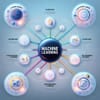In the ever-evolving world of data science, machine learning stands out as a crucial component that helps us unlock valuable insights from data. Among the various approaches, three main types—supervised, unsupervised, and reinforcement learning—serve as the foundational pillars. Each has its unique characteristics and applications, making them essential tools for data scientists.
Supervised learning is akin to having a knowledgeable guide. In this approach, algorithms learn from a labeled dataset, where each input is paired with the correct output. This process helps the model make predictions based on new, unseen data. For instance, think of a spam filter: it learns to distinguish between spam and legitimate emails by analyzing a collection of examples. Common applications include classification tasks, like identifying whether an email is spam, and regression tasks, such as predicting housing prices.
In contrast, unsupervised learning operates without labels, allowing the algorithm to explore data freely and identify patterns or groupings. This approach is particularly useful when we want to uncover hidden structures in data without predefined categories. For example, clustering algorithms can group customers based on purchasing behavior, helping businesses tailor their marketing strategies. By revealing insights that may not be immediately apparent, unsupervised learning fosters a deeper understanding of complex datasets.
Reinforcement learning takes a different route, resembling a trial-and-error learning process. Here, an agent learns to make decisions by interacting with an environment and receiving feedback in the form of rewards or penalties. This method is particularly effective for tasks requiring a sequence of actions, such as playing video games or robotics. The agent learns over time to maximize its rewards, adapting its strategy based on past experiences. This approach has led to remarkable advancements, such as AI systems that can outperform humans in complex games like chess and Go.
While each learning type has its strengths, they can also complement one another. For instance, supervised learning can be used to pre-train a model, which can then be fine-tuned with reinforcement learning. This synergy can lead to more robust and efficient systems capable of tackling complex challenges.
Understanding these three fundamental types of machine learning is vital for anyone delving into data science. Each method offers unique advantages and can be applied to a variety of real-world problems. As technology continues to advance, the potential applications of supervised, unsupervised, and reinforcement learning are virtually limitless, promising a future rich with innovation and insight.


